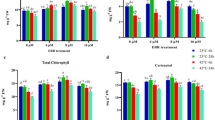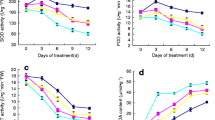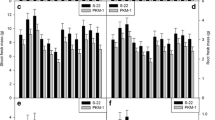Abstract
This study was carried out to better understand the role of 24-epibrassinolide (EBR) in thermotolerance of melon (Cucumis melo L.). The melon seedlings were pretreated with various concentrations of EBR (0, 0.05, 0.1, 0.5, 1.0, and 1.5 mg dm−3) as foliar spray and then exposed to a high temperature (HT) stress. Exogenous EBR (0.5–1.5 mg dm−3) alleviated HT-caused growth suppression. In parallel, 1.0 mg dm−3 EBR attenuated the decrease in chlorophyll content, net photosynthetic rate, stomatal conductance, maximum quantum efficiency of photosystem (PS) II, quantum yield of PS II, and photochemical quenching of chlorophyll a fluorescence in HT-stressed plants, and inhibited transpiration rate and non-photochemical quenching. Furthermore, exogenous EBR also significantly reduced the content of malondialdehyde (MDA) and increased the content of soluble proteins and free proline, and activities of antioxidant enzymes including superoxide dismutase, guaiacol peroxidase, catalase, and ascorbate peroxidase under the HT stress. The results show that protective effects of EBR against the HT stress in the melon seedlings were most likely mediated through the improvement of photosynthesis and the stimulation of antioxidant capacity.
Similar content being viewed by others
Abbreviations
- APX:
-
ascorbate peroxidase
- BRs:
-
brassinosteroids
- CAT:
-
catalase
- Chl:
-
chlorophyll
- ci :
-
intercellular CO2 concentration
- E:
-
transpiration rate
- EBR:
-
24-epibrassinolide
- F0 :
-
minimal fluorescence
- Fv/Fm :
-
variable to maximum fluorescence ratio in dark adapted leaves (maximum quantum yield of PS II photochemistry)
- Fv′/Fm′:
-
variable to maximum fluorescence ratio in steady-state conditions (efficiency of excitation energy capture by open PS II centers)
- gs :
-
stomatal conductance
- MDA:
-
malondialdehyde
- NBT:
-
nitroblue tetrazolium
- NPQ:
-
non-photochemical quenching
- ϕPSII :
-
effective quantum yield of PS II photochemistry
- POD:
-
peroxidase
- PS:
-
photosystem
- qP:
-
photochemical quenching
- ROS:
-
reactive oxygen species
- SOD:
-
superoxide dismutase
References
Ábrahám, E., Rigó, G., Székely, G., Nagy, R., Koncz, C., Szabados, L.: Light-dependent induction of proline biosynthesis by abscisic acid and salt stress is inhibited by brassinosteroid in Arabidopsis. — Plant mol. Biol. 51: 363–372, 2003.
Aebi, H.: Catalase. — Methods Enzymol. 105: 121–126, 1984.
Ahammed, G.J., Zhou, Y.H., Xia, X.J., Mao, W.H., Shi, K., Yu, J.Q.: Brassinosteroid regulates secondary metabolism in tomato towards enhanced tolerance to phenanthrene. — Biol. Plant. 57: 154–158, 2013.
Aebi, H.: Catalase in vitro. — Methods Enzymol. 105: 121–126, 1984.
Ainsworth, E.A., Ort, D.R.: How do we improve crop production in a warming world? — Plant Physiol. 154: 526–530, 2010.
Ali, B., Hasan, S., Hayat, S., Hayat, Q., Yadav, S., Fariduddin, Q., Ahmad, A.: A role for brassinosteroids in the amelioration of aluminium stress through antioxidant system in mung bean (Vigna radiata L. Wilczek). — Environ. exp. Bot. 62: 153–159, 2008.
Ali, B., Hayat, S., Ahmad, A.: 8-Homobrassinolide ameliorates the saline stress in chickpea (Cicer arietinum). — Environ. exp. Bot. 59: 217–223, 2007.
Asthir, B., Koundal, A., Bains, N.S.: Putrescine modulates antioxidant defense response in wheat under high temperature stress. — Biol. Plant. 56: 757–761, 2012.
Bajguz, A., Hayat, S.: Effects of brassinosteroids on the plant responses to environmental stresses. — Plant Physiol. Biochem. 47: 1–8, 2009.
Bates, L.S., Waldren, R.P., Teare, I.D.: Rapid determination of free proline for water-stress studies. — Plant Soil 39: 205–207, 1973.
Beauchamp, C., Fridovich, I.: Superoxide dismutase: improved assays and an assay applicable to acrylamide gels. — Anal Biochem. 44: 276–287, 1971.
Bradford, M.M.: A rapid and sensitive method for the quantitation of microgram quantities of protein utilizing the principle of protein-dye binding. — Anal Biochem. 72: 248–254, 1976.
Calatayud, A., Barreno, E.: Response to ozone in two lettuce varieties on chlorophyll a fluorescence, photosynthetic pigments and lipid peroxidation. — Plant Physiol. Biochem. 42: 549–555, 2004.
Dhaubhadel, S., Browning, K.S., Gallie, D.R., Krishna, P.: Brassinosteroid functions to protect the translational machinery and heat-shock protein synthesis following thermal stress. — Plant J. 29: 681–691, 2002.
Ding, H.D., Zhu, X.H., Zhu, Z.W., Yang, S.J., Zha, D.S., Wu, X.X.: Amelioration of salt-induced oxidative stress in Solanum melongena L. by application of 24-epibrassinolide. — Biol. Plant. 56: 767–770, 2012.
Dubey, R.S.: Photosynthesis in plants under stressful conditions. — In: Pessarakli, M. (ed.):Handbook of Photosynthesis. 2nd Ed. Pp. 717–737, CRC Press, Taylor and Francis Group, New York 2005.
Fariduddin, Q., Yusuf, M., Hayat, Q., Ahmad, A.: Effects of 28-homobrassinolide on antioxidant capacity and photosynthesis in Brassica juncea plants exposed to different levels of copper. — Environ. exp. Bot. 66: 418–424, 2009.
Farooq, M., Basra, S.M.A., Wahid, A., Rehman, H.: Exogenously applied nitric oxide enhances the drought tolerance in fine grain aromatic rice (Oryza sativa L.). J. Agron. Crop Sci. 195: 254–261, 2009.
Farquhar, G.D., Sharkey, T.D.: Stomatal conductance and photosynthesis. — Annu. Rev. Plant Physiol. 33: 317–345, 1982.
Gilmore, A.M.: Mechanistic aspects of xanthophyll cycle dependent photo-protection in higher plant chloroplasts and leaves. — Physiol. Plant 99: 197–209, 1997.
Goda, H., Shimada, Y., Asami, T., Fujioka, S., Yoshida, S.: Microarray analysis of brassinosteroid-regulated genes in Arabidopsis. — Plant Physiol. 130: 1319–1334, 2002.
Hasan, S.A., Hayat, S., Ahmad, A.: Brassinosteroids protect photosynthetic machinery against the cadmium induced oxidative stress in two tomato cultivars. — Chemosphere 84: 1446–1451, 2011.
Hasan, S.A., Hayat, S., Ali, B.B., Ahmad. A.: 28-Homobrassinolide protects chickpea (Cicer arietinum) from cadmium toxicity by stimulating antioxidants. — Environ. Polut. 151: 60–66, 2008.
Hayat, S., Hasan, S., Yusuf, M., Hayat, Q., Ahmad, A.: Effect of 28-homobrassinolide on photosynthesis, fluorescence and antioxidant system in the presence or absence of salinity and temperature in Vigna radiata. — Environ. exp. Bot. 69: 105–112, 2010.
Hayat, S., Yadav, S., Wani, A., Irfan, S.M., Ahmad, A.: Comparative effect of 28-homobrassinolide and 24-epibrassinolide on the growth, carbonic anhydrase activity and photosynthetic efficiency of Lycopersicon esculentum. — Photosynthetica 49: 397–404, 2011.
Janeczko, A., Oklestkova, J., Pociecha, E., Koscielniak, J., Mirek, M.: Physiological effects and transport of 24-epibrassinolide in heat-stressed barley. — Acta. Physiol. Plant. 33: 1249–1259, 2011.
Jiang, M.Y., Zhang, J.H.: Effect of abscisic acid on active oxygen species, antioxidative defence system and oxidative damage in leaves of maize seedlings. — Plant Cell Physiol. 42: 1265–1273, 2001.
Kagale, S., Divi, U.K., Krochko, J.E., Séller, W.A., Krishna, P.: Brassinosteroid confers tolerance in Arabidopsis thaliana and Brassica napus to a range of abiotic stresses. — Planta 225: 353–364, 2007.
Li, Y.H., Liu, Y.J., Xu, X.L., Jin, M., An, L.Z., Zhang, H.: Effect of 24-epibrassinolide on drought stress-induced changes in Chorispora bungeana. — Biol. Plant. 56: 192–196, 2012.
Lichtenthaler, H.K.: Cholorophylls and carotenoids: pigments of photosynthetic biomembranes. — Methods Enzymol. 148: 350–382, 1987.
Liu, Y., Zhao, Z., Si, J., Di, C., Han, J., An, L.: Brassinosteriods alleviate chilling induced oxidative damage by enhancing antioxidant defense system in suspension cultured cells of Chorispora bungeana. — Plant Growth. Regul. 59: 207–214, 2009.
Mavi, K., Demir, I.: Controlled deterioration and accelerated ageing tests predict relative seedling emergence potential of melon seed lots. — HortScience 42: 1431–1435, 2007.
Mazorra, L.M., Holton N., Bishop G.J., Núñez M.: Heat shock response in tomato brassinosteroid mutants indicates that thermotolerance is independent of brassinosteroid homeostasis. — Plant Physiol. Biochem. 49: 1420–1428, 2011.
Mittler, R.: Oxidative stress, antioxidants and stress tolerance. — Trends Plant Sci. 7: 405–410, 2002.
Nakano, Y., Asada, K.: Hydrogen peroxide is scavenged by ascorbate-specific peroxidase in spinach chloroplasts. — Plant Cell Physiol. 22: 867–880, 1981.
Nickel, R.S., Cunningham, B.A..: Improved peroxidase assay method using leuco-2,3′,6-trichloroindophenol and application to comparative measurements of peroxidase catalysis. — Anal. Biochem. 27: 292–299, 1969.
Ogweno, J.O., Son, X.S., Shi, K., Hu, W.H., Mao, W.H., Zhou, Y.H., Yu, J.Q., Nogués, S.: Brassinosteroid alleviate heatinduced inhibition of photosynthesis by increasing carboxylation efficiency and enhancing antioxidant systems in Lycopersicon esculentum. — J. Plant Growth Regul. 27: 49–57, 2008.
Ramakrishna, B., Rao, S.S.R.: 24-Epibrassinolide alleviated zinc-induced oxidative stress in radish (Raphanus sativus L.) seedlings by enhancing antioxidative system. — Plant Growth Regul. 68: 249–259, 2012.
Sasse, J.M.: Physiological actions of brassinosteroids: an update. — J. Plant Growth Regul. 22: 276–288, 2003.
Saygideger, S., Deniz, F.: Effect of 24-epibrassinolide on biomass, growth and free proline concentration in Spirulina platensis(Cyanophyta)under NaCl stress. — Plant Growth Regul. 56: 219–223, 2008.
Shahid, M.A., Pervez, M.A., Balal, R.M., Mattson, N.S., Rashid, A., Ahmad, R., Ayyub, C.M., Abbas, T.: Brassinosteroid (24-epibrassinolide) enhances growth and alleviates the deleterious effects induced by salt stress in pea (Pisum sativum L.). — Aust. J. Crop Sci. 5: 500–510, 2011.
Singh, I., Shono, M.: Physiological and molecular effects of 24-epibrassinolide, a brassinosteroid, on thermotolerance of tomato. — Plant Growth Regul. 47: 111–119, 2005.
Wahid, A., Gelani, S., Ashraf, M., Foolad, M.R.: Heat tolerance in plants: an overview. — Environ. exp. Bot. 61: 199–223, 2007.
Wise, R.R., Olson, A.J., Schrader, S.M., Sharkey, T.D.: Electron transport is the functional limitation of photosynthesis in field-grown Pima cotton plants at high temperature. — Plant Cell Environ. 27: 717–724, 2004.
Xia, X.J., Wang, Y.J., Zhou, Y.H., Tao, Y., Mao, W.H., Shi, K., Asami, T., Chen, Z., Yu, J.Q.: Reactive oxygen species are involved in brassinosteroids-induced stress tolerance in Cucumis sativus. — Plant Physiol. 150: 801–814, 2009.
Yu, J.Q., Huang, L.F., Hu, W.H., Zhou, Y.H., Mao, W.H., Ye, S.F., Nogues, S.: A role for brassinosteroids in the regulation of photosynthesis in Cucumis sativus. — J. exp. Bot. 55: 1135–1143, 2004.
Zhang, J., Li, D.M., Gao, Y., Yu, B., Xia, C.X., Bai, J.G.: Pretreatment with 5-aminolevulinic acid mitigates heat stress of cucumber. — Biol. Plant. 56: 780–784, 2012.
Author information
Authors and Affiliations
Corresponding author
Additional information
Acknowledgements: We are grateful for funding supported by the Shanghai Prosper Agriculture by Science and Technology Plan, China (Grant No. 2009-2-1) and the Open Fund of Shanghai Key Lab of Protected Horticultural Technology.
Rights and permissions
About this article
Cite this article
Zhang, Y.P., He, J., Yang, S.J. et al. Exogenous 24-epibrassinolide ameliorates high temperature-induced inhibition of growth and photosynthesis in Cucumis melo . Biol Plant 58, 311–318 (2014). https://doi.org/10.1007/s10535-014-0395-8
Received:
Revised:
Accepted:
Published:
Issue Date:
DOI: https://doi.org/10.1007/s10535-014-0395-8




